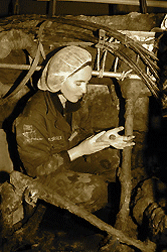|
Dr. Helen Daubmannus achieved widespread prominence within the archaeological community by decoding the Early Information Age Energy Transfer Plate, which she uncovered while gardening in her backyard. This remarkably well-preserved specimen, consisting of tangled, rubber-coated conduits connecting points on a grid, is estimated to predate known analogous machines by at least 250 years. Her research has revealed meaning in previously inscrutable artifacts, thus revolutionizing our understanding of the ancient Information Age civilization.
Site History and Excavation
An avid outdoorswoman, Dr. Daubmannus uncovered all manner of artifacts on her property and in the surrounding forest, which, according to local legend, was the site of an ancient military center. Additionally, a neighboring town claims to have been home to a revolutionary Pre-Information Age inventor. Evidence uncovered just last year suggests that certain machines on view here may be early prototypes of this inventor.
At the time of Dr. Daubmannus’s discoveries, Information Age artifacts were ubiquitous in many parts of the world, but they were often overlooked. As the implications of her research were properly understood, their historical value was recognized, and many were taken in by museums and research centers. Due to their abundance and resistance to natural decay, it’s still fairly common to uncover troves of these relics in certain areas.
Deciphering and Interpretation of Artifacts
Prior to Dr. Daubmannus’s research, experts were frustrated in their attempts to decipher the inscriptions of Late Information Age transfer plates. (These plates are typically inscribed with forking networks of brown on a turquoise copper ground accompanied by small numerals, their backs adorned with colorful beads and wires.) Although they recognized the inscriptions’ function as a written language—a cipher to be decoded—researchers were unaware of their secondary function as physical pathways through which energy and information could flow.
Without this vital knowledge, the information contained in these plates was unrecognizable and thus unavailable to anthropologists. As a result, the written records of this civilization had been lost to ruination, its culture and history known to us only through rumor. We now take for granted the progression from primitive, cumbersome, rubber tubes to flat branching mazes to the spectral order of wireless technology. At the time, however, Dr. Daubmannus’s proposed model of this technological ancestry was revolutionary.
After this sudden breakthrough, Dr. Daubmannus succeeded in decoding these networks by comparing the archaic Early Information Age transfer plate to later transfer plates. She was able to use this new knowledge, in combination with the findings of her contemporaries (Thomas Young and, in France, Jean-François Champollion), to reevaluate transfer plates and other similar machines as well as simpler, contingent artifacts. Since it was necessary for Dr. Daubmannus to conceptually reconstruct these machines from the bottom up in order to make a proper identification, this process of interpretation was, in a sense, a process of re-invention.
Implications of Research
Dr. Daubmannus's research, highly publicized, corrected common misconceptions about the Information Age civilization, for archaeologists and in minds of the general public. Her research reveals an astonishing level of technological sophistication as well as a peculiar cultural fear of natural phenomena. Although her life was short (her death, at age 45, is believed to have been caused by exposure to toxic residue from her artifacts), her influence was far-reaching. Dr. Daubmannus's discoveries ultimately lead to a re-evaluation and greater understanding of ancient Information Age society.
|
